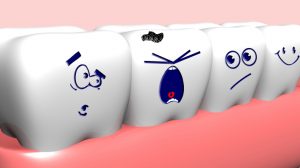
Do you know what a tooth is made of?
How much you know about your teeth? Do you know what a tooth is made of? We’ve assembled this comprehensive guide for an in-depth look at your teeth. Let’s learn more about the different kinds of teeth you have, and the different parts of a tooth as well.
The Different Kinds of Teeth
Your mouth is home to a variety of teeth, which all specialize in something different.
- Incisors: The incisors are your sharp teeth, and look like chisels. There are four incisors located in your upper jaw, and four more located in your lower jaw. These teeth help you chew your food through cutting.
- Canines: The canines are also known as cuspids. Your canines are pointy and serve to hold food in place while you chew it.
- Premolars: The premolars are also called bicuspids. Premolars feature two prominent cusps for compacting and shredding your food.
- Molars: The molars also help you chew through grinding. To make it easier to chew your food, molars feature multiple cusps on their edge.
The Different Parts of a Tooth
- Crowns: Whenever you look in a mirror and inspect your teeth, chances are you’re looking at the crown. Crowns are shaped differently depending on what the tooth is meant to do; the front teeth are sharper and are supposed to cut, while the molars in the back are flat and are designed to grind.
- Gumlines: The gumlines are where the tooth and the gum meet. Brushing your teeth and flossing properly are essential for taking proper care of your gumlines. If you don’t do it right, you run the risk of developing plaque and tartar build-ups. Too much plaque and tartar can result in gingivitis and gum disease.
- Roots: The roots are connected to the bone that stabilizes your tooth inside your mouth. The roots also account for the majority of your tooth, two-thirds of which you can’t usually see.
- Enamel: You should be the most familiar with the enamel, since it forms the topmost layer of your teeth. Although the enamel is even harder than bone, that doesn’t mean it’s indestructible – tooth decay can wreck your teeth if you allow it to go untreated.
- Dentin: Dentin is the layer of the tooth protected by the enamel. Once tooth decay has infiltrated the enamel, its next target is dentin, which leads straight to the pulp.
- Pulp: The pulp is the soft tissue inside the core of your teeth. The pulp is where all of the nerves and blood vessels reside. Once tooth decay has reached the pulp, that’s when you’ll begin to experience tooth pain.
KEEP YOUR TEETH HEALTHY WITH ANNAPOLIS DENTAL CARE
Whether you need a regular check-up or a tooth extracted, Annapolis Dental Care has the expertise and compassion to work with you on improving your oral health. Your comfort and health are our top priorities, so we go above and beyond to make our patients happy and to provide the highest quality care. To set up an appointment today, please give us a call at 410-571-5014 or visit us online. For more oral health tips for you and your family follow us on Facebook, Twitter, Google+ and YouTube!
